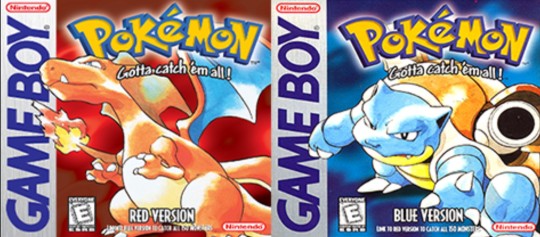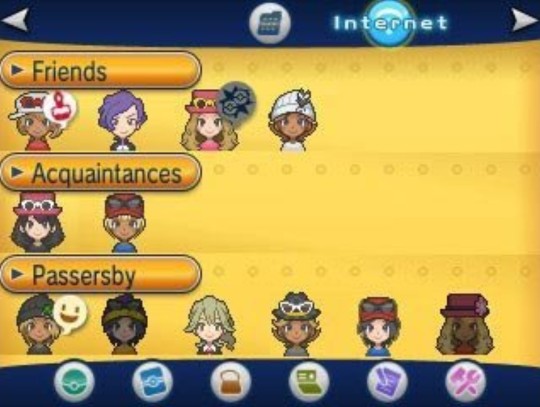Text
The Evolution of Multiplayer in Pokemon and My Pokemon Journey
Pokemon and multiplayer have always gone hand in hand. From trading and battling in Red and Blue, to taking on the journey together in Scarlet and Violet. It’s interesting how Pokemon made the most solitary genre in video games, JRPGs, into some of the best social interactions I’ve had in my entire life. From the beginning, trading and battling against other people’s teams and collections set Pokemon apart from the rest. It’s easy to think that’s really where most of the social innovation stopped, but there’s still a lot to be said on the strides this series has taken.
The way I see it, you can really split this progression into three eras. You’ve got the Game Boy era, Pokemon Generations 1-3, that were limited by hardware at the time. You had link cables or at best, a wireless adapter jutting out of your GBA. You’ve got the DS era, introducing online play (I’d argue the single largest innovation in franchise history), and you’ve got the Switch era, making experiences in Pokemon game more and more communal over the last couple generations with a touch of Pokemon Go for good measure.

The games that started it all have the simplest multiplayer experiences to offer, but they’re still evergreen pillars of the franchise in the forms of trading and battling. You and someone else with a Game Boy could square up, pitting your strongest teams against each other, or you could trade Pokemon to fill out the vast 151-strong Pokedex. Pokemon’s roots come from collecting bugs and childlike, rural exploration. By being so straight forward, the original few generations still have that organic encouragement of meeting up with other people physically, in-person. For all the advances and improvements future generations provide, a little bit of that original intent shifted over time as the internet became more and more ubiquitous.
The leap from the Game Boy to the Game Boy Advance was a massive one by almost all accounts. In terms of playing Pokemon games with other people, it was mostly the same. Link cables. By the time we get to the Hoenn region, we’re already at the point where cell phones are getting more and more common, and the internet is becoming more apart of our daily lives. GameFreak was well aware of this, carrying entire hardware peripherals that would push the likes of the Game Boy Advance further on. With the introduction of the Nintendo DS, however, everything goes global.

Pokemon Diamond and Pearl brought the series into the internet age, taking advantage of Nintendo WiFi Connection to connect trainers across the globe! It may seem novel, being able to trade and battle Pokemon online, but in 2007, this was a gamechanger. This was of a time and place where social media was relegated to MySpace and AOL instant messenger, not nearly as ever-present as the likes of Facebook and Twitter. Forums and web boards flourished with the influx of online Pokemon. This time period just so happens to be when I personally started going on community-focused websites and planted the seeds of what would become lifelong friendships. So, yeah, on a personal level, the mere act of playing and trading online really helped me navigate social waters I wasn’t even perceptive of at the time.
After such a huge step forward, what comes after feels unsurprisingly tame by comparison. Pokemon Diamond and Pearl took the franchise online, and with Black and White, it kept a majority of Gen 4’s functionality. Black and White also went in a lot of different directions in terms of silly gimmicks GameFreak likes to try generation to generation. Remember the Dream World? You’d go to an actual website on your computer or phone to meet other Pokemon and get unique items, but I mostly remember it being a giant bore. They made up for it with the C-Gear, always keeping online functionality right at that bottom screen - an improvement they would take into the next generation.

The transition from Black and White to X and Y brought us Pokemon Bank, a cloud-based application where you could continue to store your Pokemon for years to come. Pokemon had always made efforts to make sure you were able to transfer your Pokemon all the way back from Ruby and Sapphire through future generations. It’s…not the most elegant process, but with Pokemon Bank, we get a modern solution to an ever-growing Pokemon problem. It’s not a direct multiplayer facet on its own, but in the context of what you do online, it’s a crucial addition to the franchise.
X and Y by far have the easiest to use and most straightforward online functionality. It, too, existed primarily on the bottom screen, but it has a much easier to parse user interface than the C-Gear. By this point, I’m in college, and while robust online features are necessary, the attention to detail on local functionality was equally important. Pokemon X and Y were up to the task, emboldened by the Nintendo 3DS hardware, which itself was also more of a social machine (rip StreetPass).

College is also where I originally got into Pokemon Go, which honestly could use it’s own video. Pokemon Go brings back those organic roots I mentioned the original games thriving in. It’s a different experience, built for mobile devices and once again fostering community and in-person communication. I’ll never forget seeing upwards of 100 people on a cool July evening, swarming our college campus, as there were plenty of Pokestops and gyms in a walkable range. Pokemon Go was the defining social experience of 2016, and in the context of Pokemon’s multiplayer innovation, changed the series forever.
Back in the main series, we get to Pokemon Sun and Moon. I’m wrapping up my college career and the onset of Pokemon Go definitely had the following traditional generation not hit as hard on campus or online. The feature set was…fine, but they GameFreak’d it up by having it work so well in the previous generation, just to shake things up with the Festival Plaza in Sun and Moon. It was more confusing with less features, and I’d be lying if I said it didn’t have a part in my general apathy to the games at the time. Serviceable, but I have easily the least to say about it. Communication-wise, this was the calm before the storm.
Remember how I said Pokemon Go changed everything? I think it’s one of the most defining aspects of Pokemon’s transition to the Nintendo Switch, as everything from the Let’s Go remakes of the original games, to Max Raid Battles in Sword and Shield, to an entire game built around cooperative experiences, are ripped straight out of Pokemon Go. It’s by far the largest shift the franchise has had since going online.

Pokemon Let’s Go is definitely more of a footnote in the whole multiplayer aspect of Pokemon, as it stripped out a lot of the social features on top of the gameplay being a lot more like Pokemon Go in general. It does still shine a light on where the series goes next in Pokemon Sword and Shield. One of, if not THE best part of vanilla Sword and Shield were the Max Raid Battles, where you and three other people would team up to take down a Dynamax or Gigantamax Pokemon, presented very similarly to Pokemon Go’s Gym Leader battles. It wasn’t perfect, especially if you were forced to have an AI teammate or two, but it’s something they’re carrying over into Pokemon Scarlet and Violet, so you know it was a big enough impact to warrant bringing it forward.
With Pokemon Scarlet and Violet, it really feels like the culmination of a lot of different paths Pokemon has been going through the last few years, communication being front and center. They’re refining Max Raid Battles, expanding the Wild Area to the entirety of the game, and the vast majority of the game can be played cooperatively. It’s genuinely touching to be able to share all the shiny grinding, the item scouring, and every other little goofy thing we do in Pokemon - together.
2 notes
·
View notes